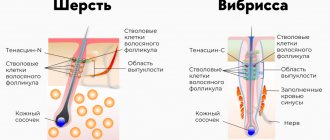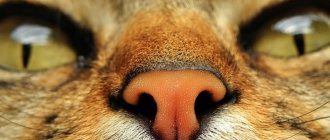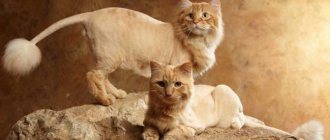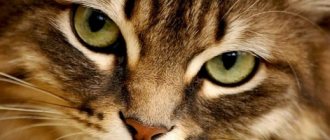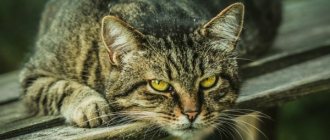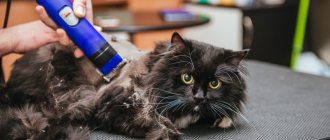The structure and location of vibrissae in male cats
Vibrissae are not hairs. They are much thicker, denser and longer. On average, the length of one cat's antennae is five to seven centimeters. Usually the length of the hairs is equal to the width of the cat's body. Unlike wool, “antennas” do not protect the kitty from cold and heat. Vibrissae on the muzzle play a completely different and no less important role.
Each cat's whisker has a curious structure and is connected to a specific part of the cat's brain. Signals received from the antennae allow the pet to formulate a complete picture of what is happening around in its head. So, these hairs consist of several elements - visible and invisible to the eye:
- invisible parts are nerve endings, cutaneous glands and skin;
- the visible part is the vibrissae itself.
The cat's whiskers are mobile due to the connective tissue bag, which contains the hair root, as well as striated muscles. The cat is able to move its antennae, direct them forward or, conversely, press them to its muzzle.
The thickness of a cat's antennae is determined by the many nerve endings and also depends on the sex of the animal. The abundance of nerve endings forms a small tubercle at the base of each hair.
The condition of the whiskers directly depends on the correct care of the pet. Cats that receive the required portion of vitamins, minerals and other beneficial components have “antennae” that are always fuller and longer.
Cat's whisker tongue
If the animal is in a calm state, then its whiskers are relaxed.
An attentive owner may notice that the pet’s whiskers are in different positions. If a cat's whiskers are pressed to its muzzle, it means that it is scared of something or is worried about something. This situation also indicates that the animal is angry and may show aggression.
If your pet's coarse hair points forward, it means he is curious or ready to interact. When he sleeps, his muzzle with mustache is relaxed. Knowing these subtleties will help you determine when you need to play with your cat or calm him down.
Why do cats and cats need whiskers and eyebrows?
A popular question, the answer to which not all owners of furry kisuls know. And whiskers actually mean a lot to cats. Scientifically speaking, vibrissae are modified organs of touch. If you look at the dictionary, the Latin word “vibrissae” literally means “to vibrate.” The follicles of the pussy's mustache and eyebrows contain a huge number of nerve endings. Thanks to the high sensitivity of the vibrissae located on the cheeks and eyebrows, cats “catch” air currents emanating from surrounding objects. This information is instantly transmitted to the brain.
If we take a closer look at the functions of the whiskers on the cheeks and eyebrows of cats, and what abilities whiskers give to cats, we can make a whole list:
- They help the cat determine the distance and size of objects. The cat correlates the information received with its size in order to make one decision or another.
- With the help of antennae and eyebrows, the cat navigates in space. Moreover, he does this both in the light and in the dark. In the dark, a kitty sees much better than a human. And their main assistant in this is the mustache.
- With the help of whiskers, the cat gets acquainted with new things. With new objects, with a new person or animal. The cat approaches an unfamiliar object, extending its “antennas” forward.
- Determination of temperature, atmospheric pressure and humidity level. Kitties feel changes in the listed indicators. If you watch a kitten as it “measures” the temperature of the environment, you will notice a slight movement of the whiskers and eyebrows. The vibrissae, which are located on the paw pads, are responsible for determining the temperature of surfaces.
- In addition, the cat uses its antennae in the area of the eyebrows and cheeks to estimate the wind speed and its direction. This information helps him calculate the force of the jump and model its trajectory.
- Eye protection. When any object touches the eyebrow whiskers, the cat automatically closes its eyes.
- Determining information about food, assessing its quality. Surely all owners have noticed that cats always sniff the bowl before they start eating from it. This way they learn what is in the feeder. The cat's whiskers near the nose and on the cheeks are responsible (for the most part) for this.
- Whiskers help mousetrap cats monitor the condition of the caught prey while it is held in their teeth.
The same functions are performed by the whiskers on the kitten's cheeks. Regardless of age, this tactile organ is necessary for a cat to live a full life.
What is a mustache for?
When learning why a cat needs whiskers , you need to realize that these hairs have many different functions:
- With their help, the cat navigates in space. Many owners constantly notice that cats manage to move around the room perfectly even in complete darkness. This happens not only because of the specific structure of the eyes, but also because of the mustache. Using vibrissae, the pet is able to measure distances and sizes of various things, as well as sense obstacles and successfully overcome them. In the same way, animals determine whether they can squeeze into a hole of a certain width.
- The cat explores the food. In order to determine how tasty and high quality food is, cats use their mouth, nose and whiskers. Vibrissae will help your pet know whether the food that is offered to him is safe.
- The cat is hunting. Even in ancient times, it was believed that the length of the whiskers helped determine how good a hunter a cat would be. Yes, the whiskers let the animal know how close the prey is and whether it is moving. A cat can smell every air vibration that a mouse or bird creates with just the tips of its whiskers. In addition, this way the cat can understand whether the prey is alive or not.
- The cat communicates. A mustache is an indicator of the pet’s mood, as well as the mood for communicating with a person. Answering the question “ why does a cat need a mustache and a tail ?”, many will immediately remember that these organs are associated with the pet’s mood. Owners who do not know why a cat needs a mustache should take a closer look at their pet in various situations. If the whiskers are pressed to the face, this means that the cat is not in the mood to play and communicate with the owner. If the whiskers are fluffy, quivering slightly and sticking out to the sides, your pet is in a great mood
What are the consequences of cutting a cat's whiskers?
Considering that the whiskers play a vital role in the life of any cat, cutting them off can lead to unpleasant consequences for the animal. Thus, according to the results of observations and research, cats and kittens whose whiskers have been cut off face the following problems:
- Deterioration of orientation in space. The animal can no longer obtain complete information about the world, since it is deprived of a tactile organ. This leads to a loss of coordination: the cat constantly crashes into everything, climbs into openings that are too narrow and gets stuck in them. In addition, the kitty begins to jump poorly. She falls before reaching her target.
- Closedness, irritation. The cat may hide in a corner and react uncertainly to what is happening.
However, not every cat faces such problems. Some cats do not change their behavior at all after losing their antennae. Outdoor cats suffer especially, since they cannot hunt without whiskers or protect themselves from dangers.
It is permissible to cut off a cat's whiskers only if there are injuries or infection of nearby tissues. But only a veterinarian should do this.
Is it possible to trim them?
Under no circumstances should the whiskers be trimmed; without this important sense organ the cat:
- unable to adequately assess the size of holes, will begin to get stuck in them;
- will often become disorientated and fall;
- will not be able to adequately assess the distance between objects.
It is known that sometimes a mother cat personally chews off the whiskers of her most active kittens so that they are calmer.
Fortunately for cats, even if someone trims their whiskers or they lose them in a fight or get burned, after some time they will grow back , like the rest of the wool. Problems with restoration can only arise when the follicle itself that holds the mustache is damaged.
The so-called whiskers are of great importance for our pets. If you want cats to feel comfortable, take care of these tough growths. Do not touch or damage them with your hands. This will save the cat’s physical and mental health.
Why do whiskers fall out and break in cats?
A healthy cat's whiskers can fall out on their own, since they also have a lifespan. If the owner notices a couple of whiskers that have fallen out, there is no need to worry. They left the hair follicle due to natural reasons. A new one will soon grow in their place.
But if you find a lot of dropped whiskers, you need to identify the cause. In most cases, the hair becomes brittle and often falls out due to normal stress, dehydration of the cat's body, and poor nutrition. The lack of microelements also affects the condition of the pet’s coat: it becomes dull and also falls out.
Pathological causes of vibrissae loss, leading to the death of hair follicles, include:
- Folliculitis. This disease involves inflammation of the hair follicles. As a rule, it is caused by various bacteria or viruses.
- Fungus. If a fungal infection affects the “whiskered” area, the whiskers begin to actively fall out along with the fur. Additionally, this area is very itchy.
- Skin diseases. These include demodicosis, lichen, dermatitis, etc. Due to skin diseases, the skin becomes inflamed and irritated, which leads to loss of the kitty's whiskers.
- Infestation with parasites. Helminths or ectoparasites (for example, fleas, ticks) affect the condition of the pet's coat and its health.
- Diseases of the endocrine system. This also includes diabetes and hypothyroidism.
Need for a tail
Why does a cat need a tail? In the life of a pet, it plays a fairly significant role, giving it dexterity and agility. By bending it upward or in another direction, the pet can avoid injuries and other dangerous moments.
Expressing emotions
From a very early age, the pet begins to show its emotional state through its tail. And if the pet begins to act up, then this can be easily “read”.
Why does a cat need a tail? If she fluffs it up, she experiences fear or irritation. In such situations, you should not approach her, giving her time to calm down. If your pet twitches its tail, there is dissatisfaction. Thus, we can say that the tail helps cats speak.
If this part of the body is relaxed, the fluffy is happy. By twitching the tip, the pet shows curiosity. A tail that sticks out shows that the cat is happy to see a person. With the help of smooth wiggles he tries to convey to us that he is ready to play.
Balancing agent
Why does a cat need a tail? This part of the body helps her not only communicate with people, but also confidently move along fences, trees, and climb to a variety of heights. With its help, the pet manages to fall on all its legs, regardless of the place from which it fell.
Help for a cat that has lost its whiskers
Any problems associated with a cat's whiskers are not only caused by harmless reasons. They often indicate the development of a serious illness in a cat.
Prevention of antennae loss consists of a small list of measures, which include:
- Air humidification in the apartment. Excessively dry air negatively affects the health of the cat.
- Proper feeding of a mustachioed pet. Regular intake of essential nutrients into the cat’s body maintains and strengthens its health and, accordingly, the condition of its whiskers. It is also important to change your pet's water daily. A drinking bowl should be freely available.
- Timely treatment against ectoparasites and helminths.
- Vaccination on time.
- Refusal to self-medicate kitty.
In a word, if a cat lives in comfortable conditions and receives adequate nutrition, he will not face problems with whiskers. But if your cat continues to lose its whiskers, and their general condition has noticeably worsened, you should consult a veterinarian as soon as possible. This is a clear symptom that indicates a problem in the cat’s body. An experienced veterinarian will definitely send the animal for tests and prescribe a specific course of treatment. Treatment will be aimed at eliminating the disease that leads to the loss of antennae in the pussycat.
On the part of the owner, strict adherence to the veterinarian’s instructions, implementation of prescribed recommendations and therapeutic procedures is required. As a rule, the cat is sent home for treatment. But in severe cases, hospital stay is required. If you follow your doctor's instructions, the effect of treatment will come very quickly.
Types and degrees of burns
The reasons for getting burns can be different. Careless behavior of the owners and active curiosity of the cat can lead to injury. Your pet may suffer the following burns:
Read also: Why is “kopek” called that?
Thermal burns are the most common option. You can accidentally spill a hot drink or food on a cat that accidentally gets under your feet. She may show excessive curiosity, “touch” the iron, tiles, jump onto a hot surface, etc.
Chemical burns are the result of contact with liquids containing acids or alkalis. The likelihood of such injury occurs if the storage rules for these dangerous drugs are not followed.
Sunburn can occur from prolonged exposure to direct sunlight. They affect mainly hairless breeds. These pets need protection from intense exposure to ultraviolet radiation.
Read also: How to be fat and beautiful?
All burns according to the scale and depth of damage to the skin are classified into 3 degrees:
- I degree is characterized by minor damage to the upper layers of the skin, redness and slight swelling are observed;
- Stage II affects the middle layers of the dermis, causing blisters to appear, which will gradually break through;
- Grade III is the most severe, causing complete damage to the structure of the integument, accompanied by tissue necrosis.
Questions and answers
Does a cat grow whiskers?
Yes, they are growing. And not just around the nose. They are located above and near the eyes, on the chin, on the paws (for example, on the pads). In total, there are about forty antennae on the cat’s body, 24 of which grow on the face.
Why do cats need mustaches?
Vibrissae are necessary for cats to determine the distance to a particular object, to orient themselves in space, to study an unfamiliar object, and to determine the temperature of the environment. In addition, the antennae protect the eyes of the small predator and help it navigate in pitch darkness.
Is the tail that important?
However, there are other opinions. Why does a cat need a tail? There are scientists who argue that it does not have a significant role in matters of balancing and communication. After all, there are breeds that do not have a tail at all. It can be lost in a certain situation. However, the pet does not stop climbing various trees and fences.
The same situation arises in communication. In addition to the tail, pets can express emotions with their eyes, paws, ears, and sounds. And if the owner of a fluffy wants to understand him, then he can find a way to do this even if there is no tail.
Interesting Facts
Owners who want to know why a cat needs a mustache will be interested in reading the following:
- the adult has approximately twenty-four whiskers;
- On average, a cat's whiskers are six to seven centimeters long;
- the Finnish cat had the longest whiskers - nineteen centimeters (he even got into the Guinness Book of Records);
- hairless cats have very short and curly whiskers, and it also happens that some hairless cats have no whiskers at all;
- Previously, people who firmly believed in omens believed that if you found a fallen cat’s whisker near the house and made a wish, it would definitely come true.
When scientists wanted to answer the question “ why do cats need whiskers ?”, they conducted a study: they removed several whiskers from kittens and began to track changes in their brains. As a result, it turned out that if the whisker did not grow, the part of the brain associated with it was replaced by the neighboring one. Such a complex process suggests that the whiskers are the most important feline organ, and should be treated with care and attention.
Cat health
Both your pet's whiskers and fur have an expiration date. The cover wears out over time, losing strength and elasticity. It happens that the owner discovers a lost whisker of his precious pet and, headlong, runs to the veterinarian with questions. Most often, if one or two whiskers fall out, this is not a symptom of any disease: a new hair will simply grow in this place. In the same way, all other wool is replaced, and human hair is a natural process.
https://youtu.be/gFYUkUA8ewg
It is important to distinguish between a fallen cat whisker and a broken one. The fallen hair at the tip has a dense thickening, a bulb, but the tip of a broken mustache will be uneven and beveled.
A cat's whiskers can break for a variety of reasons. Most often, the old mustache ceases to be sufficiently elastic, after which it breaks off due to mechanical stress. However, if your pet's whiskers split, often break off, regularly fall out, or bend in different directions and do not straighten, you should visit a doctor. Maybe the cat has a deficiency of some element, or maybe it has an infectious disease.
Mechanisms of application
Vibrissae help the cat to hunt, informing about the slightest changes in the position of the prey's body.
The kitten's large, light-colored curling whiskers activate the actions of the nerve endings - the tactile corpuscles. The base of the vibrissae is located in the blood sinus. Due to this, any fluctuation in the external environment increases and irritates the body. They form a nerve impulse that is sent to the brain. This is how the cat receives information about the space around and the location of objects. In addition, the cat has hairs on its body and front legs that act as antennas for collecting data.
